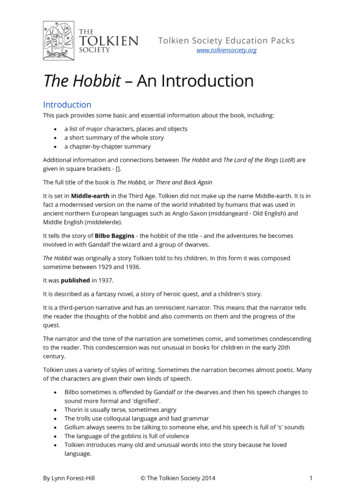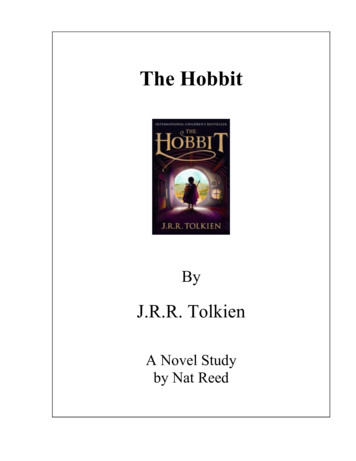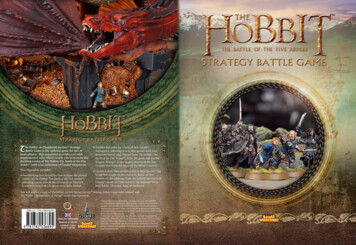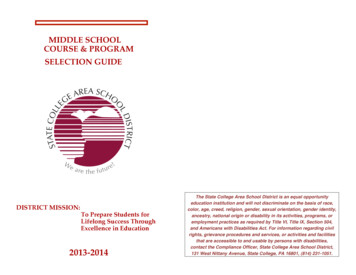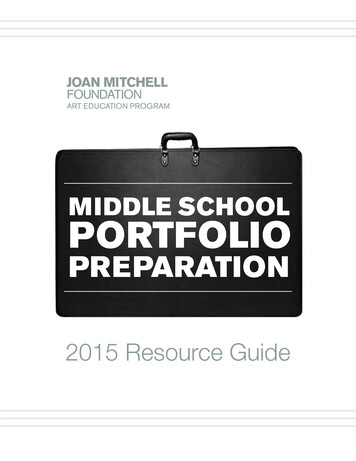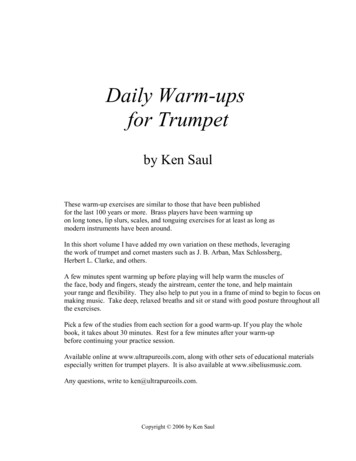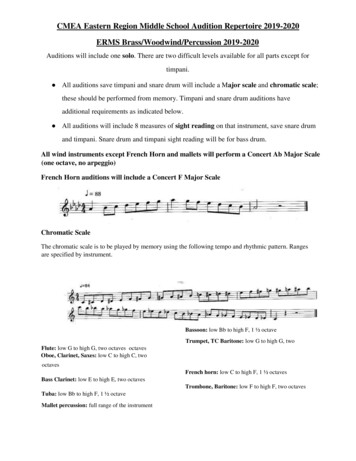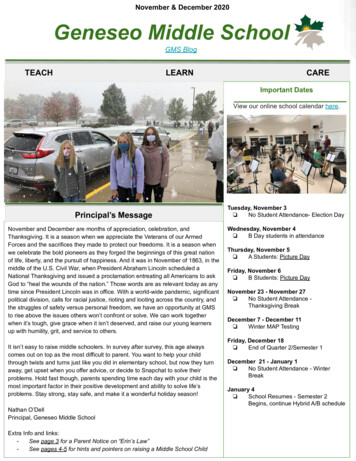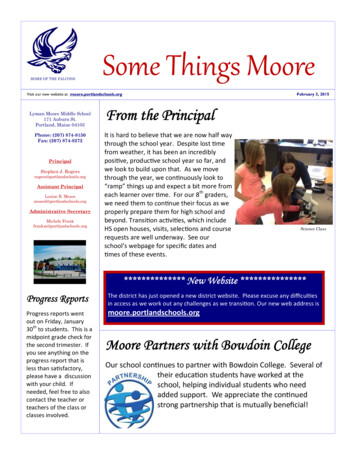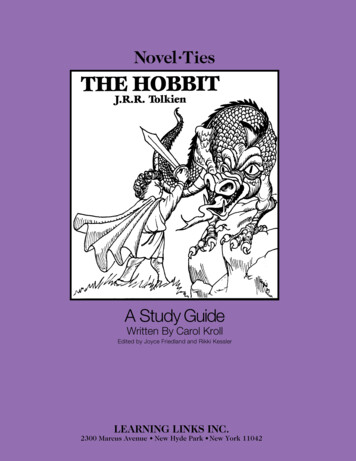
Transcription
Novel TiesA Study GuideWritten By Carol KrollEdited by Joyce Friedland and Rikki KesslerLEARNING LINKS INC.2300 Marcus Avenue New Hyde Park New York 11042
THE HOBBITFor the TeacherThis reproducible study guide to use in conjunction with a specific novelconsists of lessons for guided reading. Written in chapter-by-chapter format, the guidecontains a synopsis, pre-reading activities, vocabulary and comprehension exercises, aswell as extension activities to be used as follow-up to the novel.In a homogeneous classroom, whole class instruction with one title is appropriate. In a heterogeneous classroom, reading groups should be formed: each groupworks on a different novel on its reading level. Depending upon the length of timedevoted to reading in the classroom, each novel, with its guide and accompanying lessons,may be completed in three to six weeks.Begin using NOVEL-TIES for reading development by distributing the noveland a folder to each child. Distribute duplicated pages of the study guide for studentsto place in their folders. After examining the cover and glancing through the book,students can participate in several pre-reading activities. Vocabulary questions shouldbe considered prior to reading a chapter; all other work should be done after the chapterhas been read. Comprehension questions can be answered orally or in writing. Theclassroom teacher should determine the amount of work to be assigned, always keeping in mind that readers must be nurtured and that the ultimate goal is encouragingstudents’ love of reading.The benefits of using NOVEL-TIES are numerous. Students read goodliterature in the original, rather than in abridged or edited form. The good readinghabits, formed by practice in focusing on interpretive comprehension and literary techniques, will be transferred to the books students read independently. Passive readersbecome active, avid readers.Novel-Ties are printed on recycled paper.The purchase of this study guide entitles an individual teacher to reproduce pages for usein a classroom. Reproduction for use in an entire school or school system or for commercial useis prohibited. Beyond the classroom use by an individual teacher, reproduction, transmittal orretrieval of this work is prohibited without written permission from the publisher.Copyright 1983, 1999, 2005 by LEARNING LINKS INC.
THE HOBBITSYNOPSISBilbo Baggins, a comfort-loving conventional hobbit is the unlikely hero of thismythic tale of high adventure. In a powerful struggle between good and evil, Bilbo, thewizard Gandalf, and thirteen dwarves fight to reclaim the lost treasures and kingdom ofthe dwarf Thorin. Through his luck and a variety of experiences, Bilbo learns to deal withincreasingly difficult moral challenges.Although he would have been content to spend his days in his comfortable burrow, Bilbo is persuaded by Gandalf to join his plot to rescue the dwarf treasure from theevil dragon, Smaug. The dwarves, after frolicking in Bilbo’s home, eating all his food, andlaughing at his expense, reluctantly accept him into their band.Danger and adventures beset the group. Trolls capture Bilbo and the dwarvesand they are saved only by Gandalf ’s wizardry. At Rivendell, the elf Elrond provides themwith a map to find the Lonely Mountain. They are captured by goblins. Bilbo escapes onlyto find himself playing a game of riddles with the loathsome Gollum. But he discovers thering which allows him to become invisible.The dwarves are rescued from the goblins and Wargs by the Eagles of the MistyMountains and taken with Bilbo to the home of Beorn, a skin changer. After resting andreceiving good advice, the dwarves and Bilbo resume their quest: this time they go without Gandalf. They leave the path in Mirkwood, despite Beorn’s warning, and are capturedby giant spiders and then by wood-elves. Bilbo rescues the dwarves and hides them inbarrels which are destined for Lake-town.The Master of Lake-town and the men who live there provide safety and tellBilbo and the dwarves that the downfall of Smaug has been prophesied. They leave forthe Lonely Mountain where they find the Side-door and a thrush who helps them open it.Bilbo, fearful, but with increasing courage, goes alone into Smaug’s lair. Smaug,in an effort to destroy Lake-town, is himself destroyed. The men of Lake-town and theelves march on Lonely Mountain to share in the treasure which the dwarves believebelongs to them. Thorin sends for additional dwarves to help prepare for battle anddenies the men of Lake-town any treasure.Suddenly the men, elves, and dwarves are attacked by a vast army of goblinsand Wargs. The gory Battle of Five Armies begins. Good defeats evil. Amends are madebetween the elves and dwarves, but Thorin has been killed. Bilbo Baggins returns homehaving refused most of his share of the spoils, but far richer in character and experience.LEARNING LINKS INC.1
THE HOBBITPRE-READING ACTIVITIES1. Preview the book by reading the title and the author’s name and by looking at theillustration on the cover. What do you already know about the book? Do you think it isa book of realistic fiction or fantasy? Do you expect the book to be amusing or serious?2. The world of The Hobbit is inhabited by dwarves, trolls, elves, goblins, dragons, giants,wargs (wolves), and hobbits. These fantastic creatures are given human characteristics:they can sing, laugh, tell stories, eat, and drink. They are friendly, impetuous, andadventurous. Do you know of any people in real life or characters in fiction who sharemany of these characteristics?3. Norse and Old English mythology are the major sources of Tolkien’s inspiration forThe Hobbit. The names of the dwarves in the story come from Norse mythology. Theadventures of the Hobbit parallel those of Beowulf. The young Scandinavian warriorBeowulf delivers Hrothgar the Dane and his people from the menace of the monsterGrendel; in his old age he fights a victorious but fatal battle against a terrible dragonto save his people. What other myths or legends do you know where the forces of goodovercome the forces of evil?4. A quest in a medieval romance is the recounting of an adventurous expedition undertaken by a knight to gain an object or achieve a goal (e.g., the quest for the holy grail).As you read The Hobbit, determine how close it comes to its medieval predecessor.5. Do some research to learn about the history of runes. The classical definition of a runeis “a secret.” Certain runes represented the names of gods and were used to appeal tothem. As you read The Hobbit, notice how Old English runes are used to evoke anatmosphere of magic, mystery, and antiquity.6. Social Studies Connection: Look carefully at the map of Wilderland at the beginningof the book. Trace the path of the expedition as you read the book.7. Family ancestry plays an important part in the action of this story. Draw a family treeand record the lineage in The Hobbit as you read the story. This will help you understand complicated relationships among characters.8. Cooperative Learning Activity: Work with a small group of classmates to brainstormand create a word web showing word associations for “hobbit” and words that soundlike “hobbit.” You may be interested to learn that one definition for the word “hob” ishobgoblin or elf. As you read the book decide whether your word associations are consistent with the hobbits in the story.9. Since The Hobbit is not set in a specific historical period or geographical location, theplace and time are left to your own imagination. The settings are forests, rivers, plains,and mountains which are richly described. Tolkien tells of the shrubs, trees, and flowers growing in each area. As you read, record changes in flora and fauna and preparecollages or drawings depicting settings and inhabitants you meet in the story.LEARNING LINKS INC.2
THE HOBBITCHAPTER IVocabulary: Synonyms are words with similar meanings. Draw a line from each word incolumn A to its synonym in column B. Then use the words in column A to fill in the blanksin the sentences below.A1. prudent2. blunder3. legendary4. haughty5. audacious6. fragments7. obstinately8. parts broken off; small pieceswiseshowing great pride in oneself anddisdain for othersg. daringh. careless or stupid mistake.1. I was accused of being when I suggested we go skydiving on mybirthday.2. It is to save part of your allowance each week.3. Their enemy’s strength was , causing the smaller army to flee inretreat.4. After working overtime every night this week, I expected extra .5. No matter how much we coaxed him, my little brother refusedto go to bed.6. The servers at the new restaurant were so that no one wantedto return for another meal.7. I knew it was a(n) to ask my aunt her age when I saw her blushand hesitate to answer.8. The scientists could reconstruct an entire dinosaur just by findingof its skeleton.Questions:1. Why did Gandalf come to the home of Bilbo Baggins?2. How did the dwarves lose their treasure?3. What did you learn about Bilbo Baggins’ character when the dwarves entered his home?4. What awakened “Tookish” feelings inside Bilbo Baggins? What were some of theTookish and some of the Baggin elements in Bilbo?LEARNING LINKS INC.3
THE HOBBITChapter I (cont.)5. What happened when Mr. Baggins turned the handle and went in?6. How did Gandalf get Bilbo to agree to join the dwarves?Questions for Discussion:1. Would you like to meet a hobbit? Do you think a hobbit would be happy to meet you?2. Is your own character more like that of the Baggins or the Tooks? Which kind of character do you seek as a friend?3. Do you think Bilbo will be able to rise to the challenge presented to him?Literary Devices:I. Point of View—Point of view in literature refers to the voice telling the story. It couldbe one of the characters or the author as narrator. What is the point of view in thisstory?How would you characterize this voice?I I. Simile—A simile is a figure of speech in which a comparison between two unlikeobjects is stated directly, using the words “like” or “as.” For example:The poor little hobbit could be seen kneeling on the hearth-rug,shaking like a jelly that was melting.What is being compared?What is the effect of this comparison?LEARNING LINKS INC.4
THE HOBBITChapter I (cont.)Literary Element: Reality vs. FantasyUse the chart below to show what seems real and what seems like fantasy in the world ofhobbits. Why do you think there are some aspects of reality in the lives of the hobbits?RealityFantasyWriting Activities:1. Imagine you are Bilbo Baggins and write a journal entry expressing your conflictingemotions on the day that the dwarves arrived at your home.2. Bilbo made several statements which he later regretted. Write about a time when youmade a statement you later regretted.LEARNING LINKS INC.5
THE HOBBITCHAPTERS II – IVVocabulary: Draw a line from each word on the left to its meaning on the right. Thenuse the numbered words to fill in the blanks in the sentences .g.h.rob goods by force, especially in times of warritual repetitions of charms or spellsthought of with respect; prizedpersonal belongings; gearshake; quiverconcealment; distortionput off; avoidgrind; strike together.1. Knowing I would never the responsibility, my friend trusted meto walk her dog each day she was gone.2. I felt my heart when I realized I didn’t know any of the answerson the quiz.3. The clown barely squeezed into the car with all the necessaryfor his act.4. A master of , the magician made it seem as if his subject hadbeen sawed in half.5. First the fierce dog began to his teeth together, then heattacked.6. Cold, hungry, and without shelter, the victims looked at the results of theof their town.7. The generous and caring couple were by all who knew them.8. As she stirred her bubbling brew, the witch uttered to cast aspell upon her enemies.Questions:1. Why did Bilbo follow the dwarves’ commands?2. Why might a hobbit such as Bilbo make an excellent burglar?3. Why were the captured dwarves in great danger from the trolls?4. What caused the trolls’ downfall?LEARNING LINKS INC.6
THE HOBBITChapters II – IV (cont.)5. Why was Bilbo disappointed that Gandalf would not let him visit with the elves?6. Why did the expedition stay at Elrond’s home for as long as fourteen days?7. What important clue did Elrond find and what particular knowledge did he use tofind it?8. Why did the expedition take shelter in the cave?9. Why were the goblins furious when they saw the sword Thorin had worn?Questions for Discussion:1. Did you find the trolls to be a frightening threat, a humorous diversion, or both?2. Do you think the dwarves and Bilbo will ever return to claim the treasure they plundered from the trolls?3. What special qualities do you think Gandalf possessed which enabled him to rescuehis friends?Literary Devices:I. Personification—Personification refers to a literary device in which the authorendows inanimate objects with human qualities or actions. For example:Boulders, too, at times came galloping down the mountain-sides,let loose by midday sun upon the snow. . .What is being personified?How does this help you visualize the scene?Find another example of personification. Provide page number.LEARNING LINKS INC.7
THE HOBBITChapters II – IV (cont.)I I. Foreshadowing—Foreshadowing refers to the clues an author provides to suggestwhat will happen later in the story. What did the following passage foreshadow?That, of course, is the dangerous part of caves: you don’t knowhow far they go back, sometimes, or where a passage may leadto, or what is waiting for you inside.Art Connection:Tolkien never described the appearance of the goblins. Use your imagination to draw agoblin. Compare our imagined goblins with those of your classmates.Writing Activity:Use the device of personification to enhance a written description of a scene that isfamiliar to you.LEARNING LINKS INC.8
THE HOBBITChapters II – IV (cont.)Literary Element: CharacterizationUse the diagram below to compare the characteristics of hobbits, dwarves, trolls, elves,and goblins. Record the characteristics they have in common in the center circle.hobbitsdwarvestrollsgoblinselvesLEARNING LINKS INC.9
THE HOBBITCHAPTERS V – VIIVocabulary: Draw a line from each word on the left to its definition on the right. Thenuse the numbered words to fill in the blanks in the sentences nging to the past; not moderncausing dismay or horrorundergoing mental or emotional strainarea overgrown with ferns and shrubsharsh; grim; desolateundergroundsmall bite or portion, as of foodbridge made of horizontal bars resting on A-frames.1. We felt the sway beneath our feet as we walked across duringthe storm.2. Everyone huddled in the tunnels, hoping to protect themselvesfrom the approaching tornado.3. Even though I was well prepared, I became as the moment ofthe gymnastics competition drew near.4. There wasn’t a tree or a flower to brighten the appearance of thelandscape.5. I prefer the charm and coziness of furniture to the efficiency ofnew objects.6. My dog is so small, it survives on only a(n) of food each day.7. The hid the long-unused road to our cabin in the woods.8. No one could forget the scene of overturned cars and woundedpassengers at the site of the accident.Questions:1. In what condition did Bilbo find himself when he regained consciousness?2. Why did Bilbo play a riddle game with Gollum?3. What did Bilbo learn about the ring from Gollum’s mutterings?4. How did Bilbo escape from the dark place?5. Why did Gandalf have a strong allegiance toward Bilbo?LEARNING LINKS INC.10
THE HOBBITChapters V – VII (cont.)6. Why didn’t Bilbo tell the dwarves about the magic ring?7. Why did the wolves flee from the area where the dwarves were hiding?8. How did Bilbo and the dwarves escape the fire in the trees?9. What caused Gandalf to decide that it was time to leave the quest?10. Why was Beorn called a “skin changer”?11. Why was Beorn willing to help Gandalf and the others?Questions for Discussion:1. Which magical creature that you have come upon in the story so far is the scariest?Which is the most likeable?2. Why do you think the author found it necessary to have Gandalf leave the expedition?3. What do you think Bilbo had achieved through his trait of cleverness?4. Do you think that Bilbo and the dwarves will accomplish their goal without Gandalfto help?Literary Element: CharacterizationUse a chart, such as the one below, to provide examples of the growth in wisdom, courage,and initiative shown by the dwarves and by Bilbo.DwarvesBilbowisdomcourageinitiativeWriting Activities:1. Reread the first two pages of Chapter VII. Using this descriptive passage as a model,write your own descriptive passage in which you imagine you are flying over andlanding in your neighborhood.2. Write about a goal or a destination that you wish to reach. Enumerate the skillswhich allow you to achieve this. Explain whether you think you can reach this goaland how its achievement might change your life.LEARNING LINKS INC.11
THE HOBBITCHAPTERS VIII – XVocabulary: Use the context to figure out the meaning of the underlined word in each ofthe following sentences. Compare your definitions with dictionary definitions. As Bilbo’s sharp inquisitive eyes became used to the dark, he could see the dwarveshiding behind the trees. Bombur continued to sleep with a smile on his face, no longer caring for all the problemsthat vexed them. The portcullis was often open, allowing a lot of traffic to go in and out near the watergate. The wine was so potent it made the wood-elf drowsy. An ominous nod in the direction of the mountain signaled to us that there was a dangerous dragon lurking there. The Master, looking forward to peace in the land, wished for no enmity between himselfand the more powerful Elvenking.WordYour DefinitionDictionary Definition1. inquisitive2. vexed3. portcullis4. potent5. ominous6. enmityQuestions:1. Why did the Hobbit and dwarves neglect to follow the advice given by Beorn andGandalf?2. What role did luck play in the rescue of the dwarves?3. What experiences in the forest caused Bilbo to have an improved self-concept?4. What misunderstanding caused the dwarves to be imprisoned?5. Why didn’t Thorin want the Elvenking to know about his quest?6. What was Bilbo’s first job a a burglar?7. Describe Bilbo’s plan for escape. When did luck help?LEARNING LINKS INC.12
THE HOBBITChapters VIII – X (cont.)8. What news did Gandalf receive that made him decide to rejoin Bilbo?9. What were the attitudes of the inhabitants of Lake-town toward Thorin’s mission?How did their attitudes compare with those of their Master and of the Elvenking?10. Why did the Master help Thorin and his group? How did he help them?Questions for Discussion:1. What special qualities do you think Bilbo and Thorin possessed that caused themto emerge as leaders of the group?2. In Chapter Eight, Tolkien wrote, “. . . if Bilbo had had the sense to see it. . .”What do you think Tolkien meant by this statement?3. Who do you think had a more realistic attitude toward the mission—Bilbo or thedwarves?Literary Element: CharacterizationBilbo had many skills which emerged during his experiences in the forest. Use the chartbelow to describe some of them and tell how they helped him.Bilbo’s SkillHow It HelpedWriting Activity:Imagine you are Bilbo Baggins. Choose one of your adventures and write a journal entrydescribing your thoughts and feelings immediately after the adventure ended.LEARNING LINKS INC.13
THE HOBBITCHAPTERS XI – XIIIVocabulary: Analogies are equations in which the first pair of words has the samerelationship as the second pair of words. For example: COMEDY is to TRAGEDY asCOMMENCE is to CONCLUDE. Both pairs of words are opposites. Choose the bestword from the Word Box to complete each of the analogies below.cowardcranniesWORD BOXlairpallidmaraudingperilouswaning1. INCREASING is to DECREASING as WAXING is to .2. BEAR is to DEN as COUGAR is to .3. CAREFUL is to CAUTIOUS as DANGEROUS is to .4. HEALING is to DOCTORS as is to BANDITS.5. FORESTS is to WOODS as is to CREVICES.6. VIBRANT is to as BRAVE is to COWARDLY.7. CRINGED is to as NAPPED is to DOZED.Questions:1. What happened to permit Thorin to fit the key into the hole? What rune and moonletters letters prophesied this?2. How did the dwarves let Bilbo down? How did Bilbo differ from the dwarves?3. What was meant by “the desire of dwarves”?4. What was the one useful thing that Bilbo learned as a result of his second encounterwith the dragon?5. Why did Bilbo take the Arkenstone? What were his feelings when he took it?6. Why did the dwarves take so much treasure from the dragon’s lair?7. Why did the dwarves and Bilbo leave the palace? How did Balin and Thorin knowhow to escape?LEARNING LINKS INC.14
THE HOBBITChapters XI – XIII (cont.)Questions for Discussion:1.What enabled Bilbo to become so brave?2. What is true courage?3. What was the real battle Bilbo fought in the tunnel?Writing Activity:Bilbo calls himself by many names. Use the chart below to describe the adventure thatled to each name. The first one has been done for you.Bilbo’s NameClue-finderAdventurediscovery of the knocking thrush at the tunnel-gateWeb-cutterStinging flyChosen for thelucky numberBuries his friends aliveNo bag went over meFriend of bearsGuest of eaglesRingwinnerBarrel-riderNow write about an adventure you might have. Choose an appropriate name for yourself.LEARNING LINKS INC.15
THE HOBBITCHAPTERS XIV – XVIVocabulary: Use the words in the Word Box and the clues below to solve the crosswordpuzzle.amendsbadebenefactorWORD enpropheciesAcross2. one who gives financialor other aid5. predictions; revelations8. foretelling; giving warning10. past tense of bid11. reparations or paymentsmade as satisfaction forinsult or injuryDown1. weakened by old age,illness or hard use3. towering above others;outstanding4. prevented from beingsuccessful6. weighed down with a load7. wished for excessively9. gloomyLEARNING LINKS INC.16
THE HOBBITChapters XIV – XVI (cont.)Questions:1. What did the burglar’s title “Barrel-rider” indicate to Smaug?2. Bard showed his skill and intelligence by instructing the villagers to cut the bridgesand by slaying the dragon. What part did his lineage play in his success?3. Why did the Master reveal that “I am the last man . . .” Of whom is he speaking?Why did he make this statement at this particular time?4. What were the differences between the Master and Bard? What leadership qualitiesdid each have? Who killed Smaug?5. Why did the Elvenking decide to leave home and travel to Esgarath?6. Why was Bilbo willing to end his quest with the killing of Smaug, while Thorin wasnot?7. What did Bombur mean when he said that Thorin was a dwarf with a stiff neck?Questions for Discussion:1. What do you think of the advice given to Thorin by Roac, son of Carc? Would youhave followed the advice? Reviewing all that has happened so far, evaluate Bard’sposition. Do you agree with his requests? How does his approach to Thorin comparewith Thorin’s responses? What qualities of leadership did both display?2. In handing over the Arkenstone to Bard, Bilbo exhibited the most noble kind of heroism.Discuss Bilbo’s character. What character traits permitted this act of nobility?Writing Activity:Think about some real people you know or have read about who are leaders. What qualities of leadership do they display? Choose one person and write a character sketch aboutthat person in which you describe leadership qualities as well as other characteristics.LEARNING LINKS INC.17
THE HOBBITCHAPTERS XVII – XIXVocabulary: Choose the best word from the Word Box to complete each of the analogiesbelow.altercasketWORD BOXcontentonslaughtponderwrath1. BRAID is to PLAIT as CHANGE is to .2. TRUMPET is to BRASS as is to WOOD.3. ANGER is to as CONFUSION is to BEWILDERMENT.4. DECEIT is to HONESTY as CONCLUDE is to .5. SURRENDER is to as GATHER is to DISPERSE.6. is to ECSTATIC as SAD is to DEPRESSED.Questions:1. What did Thorin promise Bard in exchange for the Arkenstone?2. Why did Dain’s army attack first?3. Why did the Elvenking set aside his anger at Thorin and decide that he would notbegin a war for gold?4. Why did Dain agree to join with Bard and the Elvenking when Gandalf said it wastime for council?5. What was the Goblins’ behavior toward their own during the onslaught?6. Why did Bilbo stand on Ravenhill with the elves at the end of the battle?7. In what spirit did Dain give his gifts? How did this differ from Thorin’s promises?8. What did the elf poem reveal about the hobbit’s feelings?9. What happened to Bilbo’s reputation as a result of his adventures?10. Why didn’t Bilbo Baggins visit with his friends in the North?LEARNING LINKS INC.18
THE HOBBITChapters XVII – XIX (cont.)Questions for Discussion:1. Do you think Thorin’s quest was fulfilled? Why do you think his death was necessary?Do you think he deserved the reader’s admiration?2. Do you agree with Bilbo’s thought that “he made a great mess of that business withthe stone”?Writing Activity:A quest is a search made to secure an object or achieve a goal. In the Middle Ages anadventure undertaken by a knight or knights was called a “Quest.” In what ways mayBilbo’s adventures be seen as a “Quest” story? Write a short essay describing Bilbo’s questand tell how he matured during the course of his quest.LEARNING LINKS INC.19
THE HOBBITCLOZE ACTIVITYThe following passage is taken from Chapter One of the book. Read it through completelyand then go back and fill in the blank spaces with words that make sense. Then you maycompare your language with that of the author.By some curious chance one morning long ago in the quiet of the world, whenthere was less noise and more green, and the hobbits were still numerous and prosperous,and Bilbo Baggins was standing at his door after breakfast smoking an enormous longwooden pipe that reached nearly down to his woolly toes (neatly brushed)—Gandalf cameby. Gandalf ! If you had 1 only a quarter of what I have2 about him, and I have only heard 3 little of allthere is to hear, 4 would be prepared for any sort of 5tale. Tales and adventures sprouted up all 6 the place whereverhe went, in the 7 extraordinary fashion. He had not been down8 way under The Hill for ages and ages, 9 sincehis friend the Old Took died, in ,10 and the hobbits had almost forgotten what 11 looked like. He had been away 12 TheHill and across The Water on businesses of 13 own since they were allsmall hobbit-boys 14 hobbit-girls.All that the unsuspecting Bilbo saw 15 morning was an oldman with a .16 He had a tall pointed blue hat, 17long grey cloak, a silver scarf over 18 his long white beard hung downbelow his ,19 and immense black boots.“Good morning!” said ,20 and he meant it. The sun was,21 and the grass was very green. But Gandalf 22at him from under long bushy 23 that stuck out further than the brim24 his shady hat.“What do you mean?” 25 said. “Do you wish me a good,26 or mean that it is a good 27 whether I want itor not; or 28 you feel good this morning; or 29 it isa morning to be good ?” 30“All of them at once,” said Bilbo. “ 31 a very fine morning fora pipe 32 tobacco out of doors, into the bargain. 33you have a pipe about you, sit 34 and have a fill of mine! There’s35 hurry, we have all the day before !” 36 ThenBilbo sat down on a seat by his door, crossed his legs, and blew out a beautiful grey ringof smoke that sailed up into the air without breaking and floated away over The Hill.LEARNING LINKS INC.20
THE HOBBITPOST-READING ACTIVITIES1. Return to the family tree that you began in the Pre-Reading Activities on page two ofthis study guide. Make any additions and corrections that seem appropriate now thatyou have finished the book. Compare your family tree with those of your classmates.2. Cooperative Learning Activity: Work with a small group of your classmates tomake a list of the creatures who came to the aid of Bilbo and the dwarves in theirquest. Indicated how each group helped Bilbo and why they helped.3. Gandalf says to Bilbo and the dwarves as he leaves them at the edge of Mirkwood,“We may meet again before it is all over,
like “hobbit.” You may be interested to learn that one definition for the word “hob” is hobgoblin or elf.As you read the book decide whether your word associations are con - sistent with the hobbits in the story. 9. Since The Hobbit is not set in a specific historical period or File Size: 258KB

